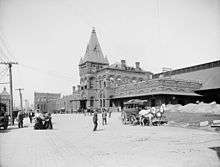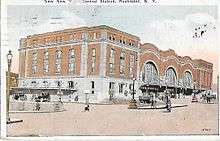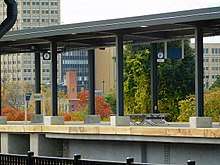Rochester station (New York)
Rochester, NY | ||||||||||||||||||||||||||||||||||||||||||||||||||||||||||||||||||
|---|---|---|---|---|---|---|---|---|---|---|---|---|---|---|---|---|---|---|---|---|---|---|---|---|---|---|---|---|---|---|---|---|---|---|---|---|---|---|---|---|---|---|---|---|---|---|---|---|---|---|---|---|---|---|---|---|---|---|---|---|---|---|---|---|---|---|
 The new Amtrak station in October 2017. | ||||||||||||||||||||||||||||||||||||||||||||||||||||||||||||||||||
| Location |
320 Central Avenue Rochester, NY 14605 | |||||||||||||||||||||||||||||||||||||||||||||||||||||||||||||||||
| Coordinates | 43°09′49″N 77°36′30″W / 43.1635°N 77.6082°WCoordinates: 43°09′49″N 77°36′30″W / 43.1635°N 77.6082°W | |||||||||||||||||||||||||||||||||||||||||||||||||||||||||||||||||
| Owned by | Amtrak | |||||||||||||||||||||||||||||||||||||||||||||||||||||||||||||||||
| Line(s) | Empire Corridor (Rochester Subdivision) | |||||||||||||||||||||||||||||||||||||||||||||||||||||||||||||||||
| Platforms | 1 island platform (formerly had 6 island platforms) | |||||||||||||||||||||||||||||||||||||||||||||||||||||||||||||||||
| Tracks | 4 (formerly 11) | |||||||||||||||||||||||||||||||||||||||||||||||||||||||||||||||||
| Bus operators |
| |||||||||||||||||||||||||||||||||||||||||||||||||||||||||||||||||
| Construction | ||||||||||||||||||||||||||||||||||||||||||||||||||||||||||||||||||
| Parking | Yes; free | |||||||||||||||||||||||||||||||||||||||||||||||||||||||||||||||||
| Bicycle facilities | Yes | |||||||||||||||||||||||||||||||||||||||||||||||||||||||||||||||||
| Disabled access | Yes | |||||||||||||||||||||||||||||||||||||||||||||||||||||||||||||||||
| Other information | ||||||||||||||||||||||||||||||||||||||||||||||||||||||||||||||||||
| Station code | Amtrak code: ROC | |||||||||||||||||||||||||||||||||||||||||||||||||||||||||||||||||
| History | ||||||||||||||||||||||||||||||||||||||||||||||||||||||||||||||||||
| Opened |
Original depot: 1914 Amtrak facility: 1978 | |||||||||||||||||||||||||||||||||||||||||||||||||||||||||||||||||
| Rebuilt | 2017 | |||||||||||||||||||||||||||||||||||||||||||||||||||||||||||||||||
| Electrified | No | |||||||||||||||||||||||||||||||||||||||||||||||||||||||||||||||||
| Traffic | ||||||||||||||||||||||||||||||||||||||||||||||||||||||||||||||||||
| Passengers (2017) |
127,203[1] | |||||||||||||||||||||||||||||||||||||||||||||||||||||||||||||||||
| Services | ||||||||||||||||||||||||||||||||||||||||||||||||||||||||||||||||||
| ||||||||||||||||||||||||||||||||||||||||||||||||||||||||||||||||||
| ||||||||||||||||||||||||||||||||||||||||||||||||||||||||||||||||||
Rochester station is an Amtrak intermodal transit station in Rochester, New York. Local and regional bus transportation is provided by the Rochester-Genesee Regional Transportation Authority (RGRTA). Various taxi firms service the station, as well. The station is located on the north side of Rochester, just east of High Falls on the south side of the tracks.
Rochester is served by three Amtrak routes, totalling eight trains each day. The Lake Shore Limited operates one train in each direction daily between Chicago and Boston/New York City (via two sections east of Albany), while the Empire Service operates two trains in each direction between Niagara Falls and New York City, and the Maple Leaf serves the station with one train in each direction between Toronto and New York City. The current station is the third train station to be built at the current site, it was opened in 2017.
History
Rochester has a long history of train stations. The first major Rochester station was built in 1845 by the New York Central Railroad on Mill Street by High Falls.

In the 1880s, the railroad tracks were elevated (having previously been at grade) and in 1882 the station was relocated to the east side of the Genesee River, close to the modern station site on Central Avenue at St. Paul Street. This station was notable for its large train shed. Not long after the 1882 station was established, the city of Rochester would have four major train stations, The New York Central station, the since demolished Erie Railroad Depot, the Lehigh Valley Railroad Station that currently houses Dinosaur Bar-B-Que and the Rochester terminal of the Buffalo, Rochester, and Pittsburgh Railway which currently houses Nick Tahou Hots.[2]

The 1882 station would be demolished and replaced in 1914 at the modern site by the more famous New York Central station designed by Claude Fayette Bragdon. The station, often referred to as Bragdon Station, was four stories with three high arching windows reminiscent of train driving wheels and a main room that was reminiscent of New York’s Grand Central Terminal complete with arched ceilings and a lunch counter. The station at its height had 6 island platforms connected to the main station building by two tunnels, one for passengers and one for baggage and mail that went all the way to the Cumberland St. Central Post Office. The station was seen as one of Bragdon's greatest architectural accomplishments. As was the case with several large union stations of the era, with falling revenues and the high maintenance costs and taxes of such a large facility the station was sold by the New York Central Railroad in 1959 to a private owner.
In a move that is largely considered today to have been a mistake, the famed 1914 station was mostly demolished in 1965 after its sale to private owners except for the then run down westernmost portion which served as the station in the interim (with the ticket sales at the entrance to the passenger tunnel). That section was demolished in 1977 to make way for an Amtrak facility in 1978. The passenger, baggage tunnels and one of the platform canopies of the original 1914 building were the last remaining remnants of the previous 1914 station to survive. The tunnels, long forgotten were re-discovered during initial surveying work for the current station.[3] During the construction of the station in 2015, the tunnels were filled in as part of the construction of a new tunnel for the station, the westernmost part of the canopy remains.
The 1978 structure was an Amshack style station similar to other stations Amtrak was building at the time as part of their Standard Stations Program. All trains during this time used a side platform adjacent to the station building, meaning both eastbound and westbound trains had to switch to the southern track. This caused conflicts with other passenger and freight trains and led to delays. The 1978 station also did not have high-level platforms, meaning passengers had to climb several steps to board trains. The station (which was later claimed to be temporary) was long outdated by the time it was demolished in late 2015 to make way for the current station.[4]
Construction on the current multi model transit center broke ground on October 28, 2014. The station was completed and opened on October 6, 2017 in a ceremony attended by Congresswoman Louise Slaughter, Mayor Lovely Warren and Governor Andrew Cuomo.[5] The project to build the station was allocated by The City of Rochester, State of New York, and Amtrak US$26.5 million (later US$29.5 million) for construction.[6][7] Rochester's station, part of a rebuilding of the Empire Corridor was built around the same time as a new station in Niagara Falls (completed in 2016) and an upcoming new station in Schenectady.
On March 17, 2018, a day after the death of Congresswomen Slaughter, Senators Chuck Schumer and Kirsten Gillibrand along with former Mayor and Lieutenant Governor Bob Duffy made a request to Amtrak to rename the station after Slaughter who played a significant part in securing the funding for the station.[8] Four days later, Amtrak announced that it would rename the station.[9]
Station layout

The two floor station is 9,500 square feet. Designed to look like the original 1914 Bragdon station, it includes the 1914 station's original clock and plaques from both the 1914 station and 1882 station.[10][11] Trains call at a single high-level center island platform serving one track in each direction for Amtrak, with two others on either side in each direction for freight traffic to pass by. The platform is connected to the station building via a tunnel underneath the tracks that is accessed by stairs, escalator and elevator.[7] The station also contains two retail stands and many display boards.
To the side of the station is future parking allocation for Greyhound and Trailways buses, which currently stop at a temporary facility across the street as part of a phase 2 plan to directly incorporate buses into the station. It was also built to accommodate proposed high-speed rail service.[6]

| P Platform level |
Track 4 (Mainline) | No passenger service |
| Track 3 | ← Empire Service toward Niagara Falls, NY (Buffalo – Depew) ← Maple Leaf toward Toronto (Buffalo – Depew) ← Lake Shore Limited toward Chicago (Buffalo – Depew) | |
| Island platform, doors will open on the left or right | ||
| Track 2 | Empire Service, Maple Leaf toward New York City (Syracuse) → Lake Shore Limited toward New York City or Boston (Syracuse) → | |
| Track 1 (Mainline) | No passenger service | |
| Side platform, no passenger access | ||
| G | Street level | Exit/entrance and station building |
Bus connections
The station is across the street from the Greyhound/Trailways station and phase 2 of the new station is to include the buses.
RGRTA service includes the 37/37x Clinton and the 41/41X Joseph, both of which go to the nearby RTS Transit Center.
Immigration checkpoint
In 2010 U.S. Border Patrol agents [12] boarded the trains at Rochester station and asked passengers for details of their citizenship. At that time passengers who were not able to suitably prove their right to be in the U.S. could have been removed from the train and taken into custody.
References
- ↑ "Amtrak Fact Sheet, FY2017, State of New York" (PDF). Amtrak. November 2017. Retrieved 5 January 2018.
- ↑ "Monroe County (NY) Library System - Pathfinders - Architecture - Lost Rochester".
- ↑ https://www.dot.ny.gov/main/business-center/designbuildproject/repository/NY-Rochester-Station_Report-Evaluation_Tunnels_2012_04_19.pdf
- ↑ "Rochester, NY (ROC)".
- ↑ http://wxxinews.org/post/rochesters-new-train-station-open-business
- 1 2 Orr, Steve (October 29, 2014). "Ground broken for Amtrak station". Democrat & Chronicle. Retrieved December 21, 2014.
- 1 2 "Officials will break ground on Rochester train station in August". Democrat and Chronicle. April 3, 2013. Retrieved 2013-04-04. External link in
|publisher=(help) - ↑ WHAM. "New York Senators call on Amtrak to rename Rochester train station after Louise Slaughter". WHAM. Retrieved 2018-03-17.
- ↑ Abrams, Jason (March 21, 2018). "Amtrak to Name Rochester Station in Honor of Congresswoman Louise M. Slaughter". Amtrak Media.
- ↑ http://www.democratandchronicle.com/story/news/2017/08/31/clock-rochester-central-station-back-city/619543001/
- ↑ https://www.dot.ny.gov/rochesterstation/faq
- ↑ "Border Sweeps in North Reach Miles Into U.S." The New York Times. August 30, 2010.
External links
![]()
